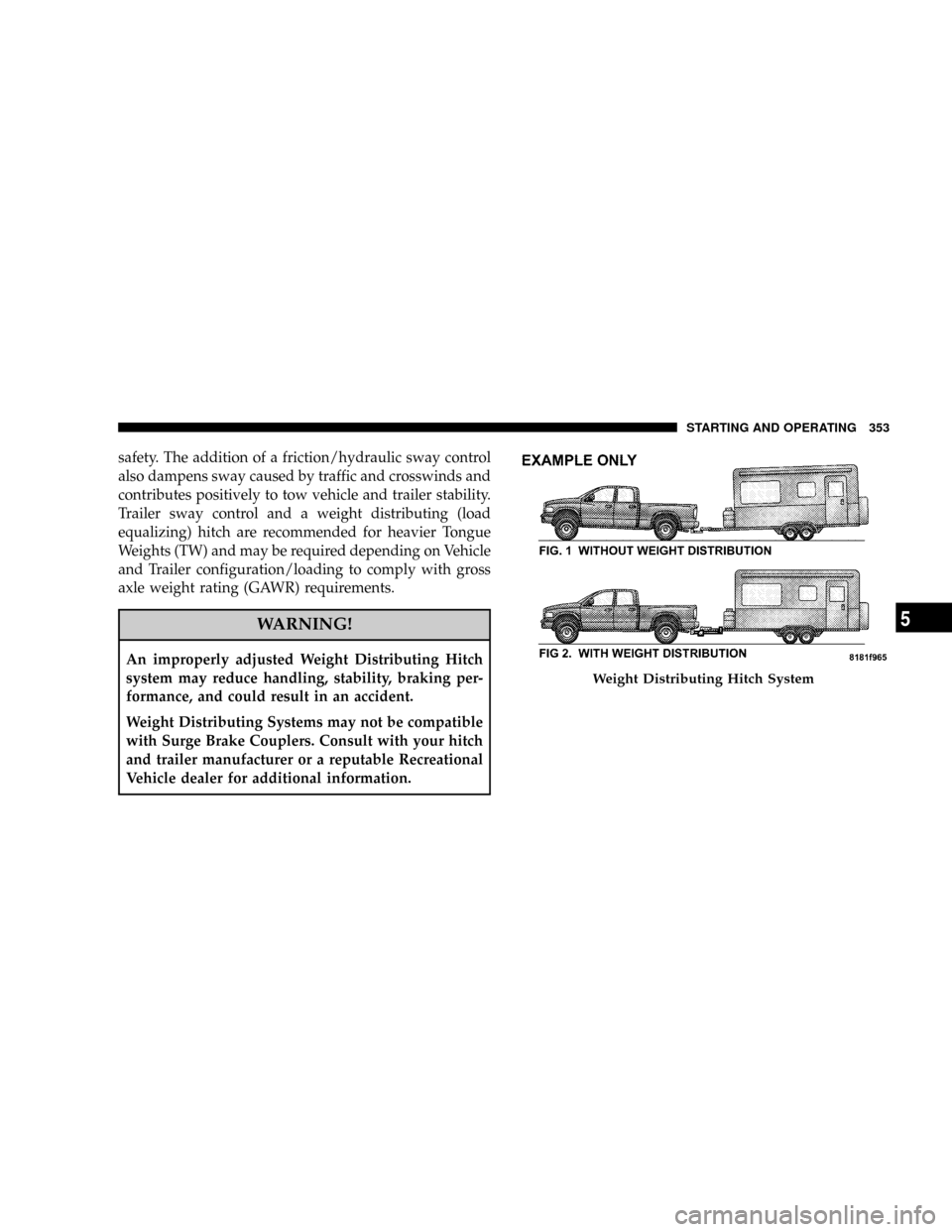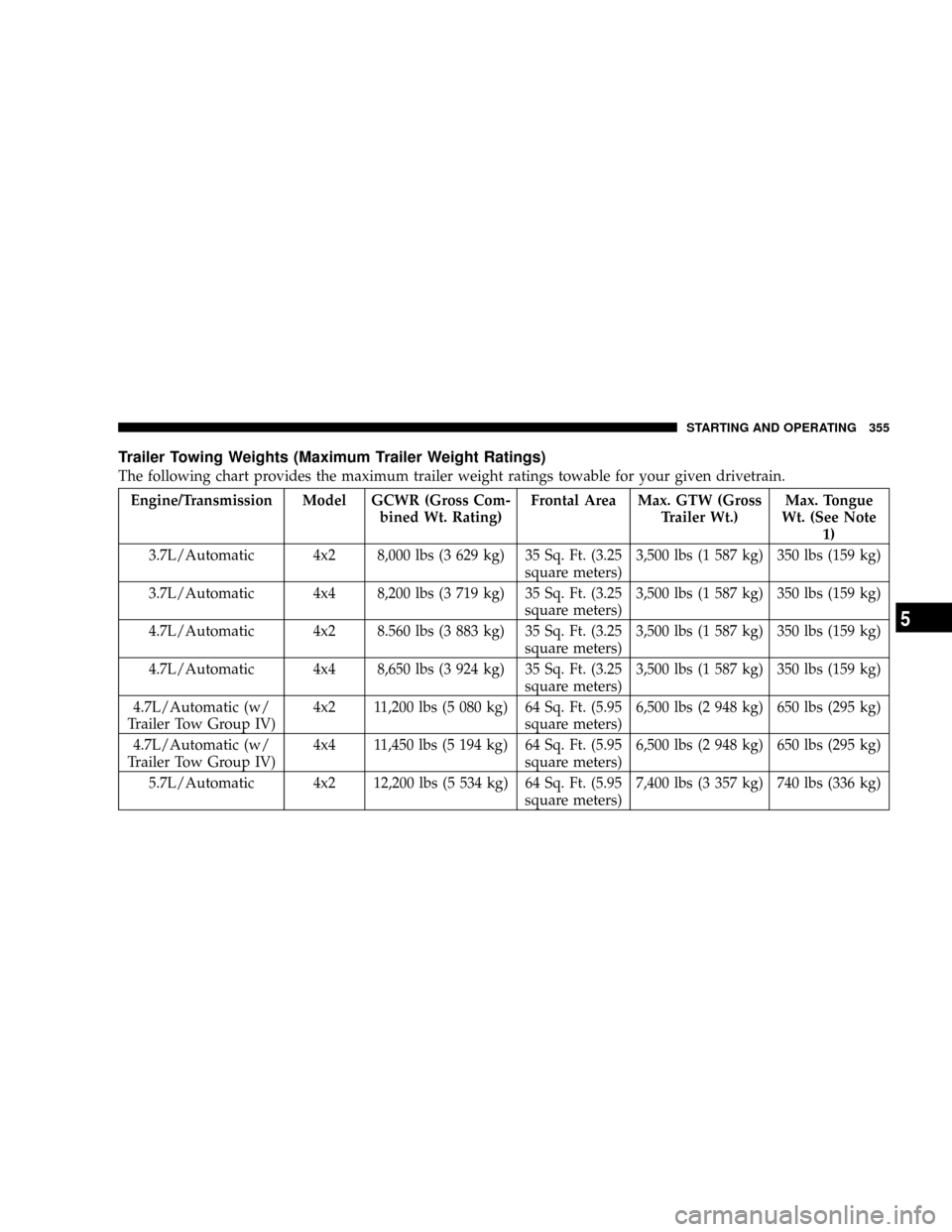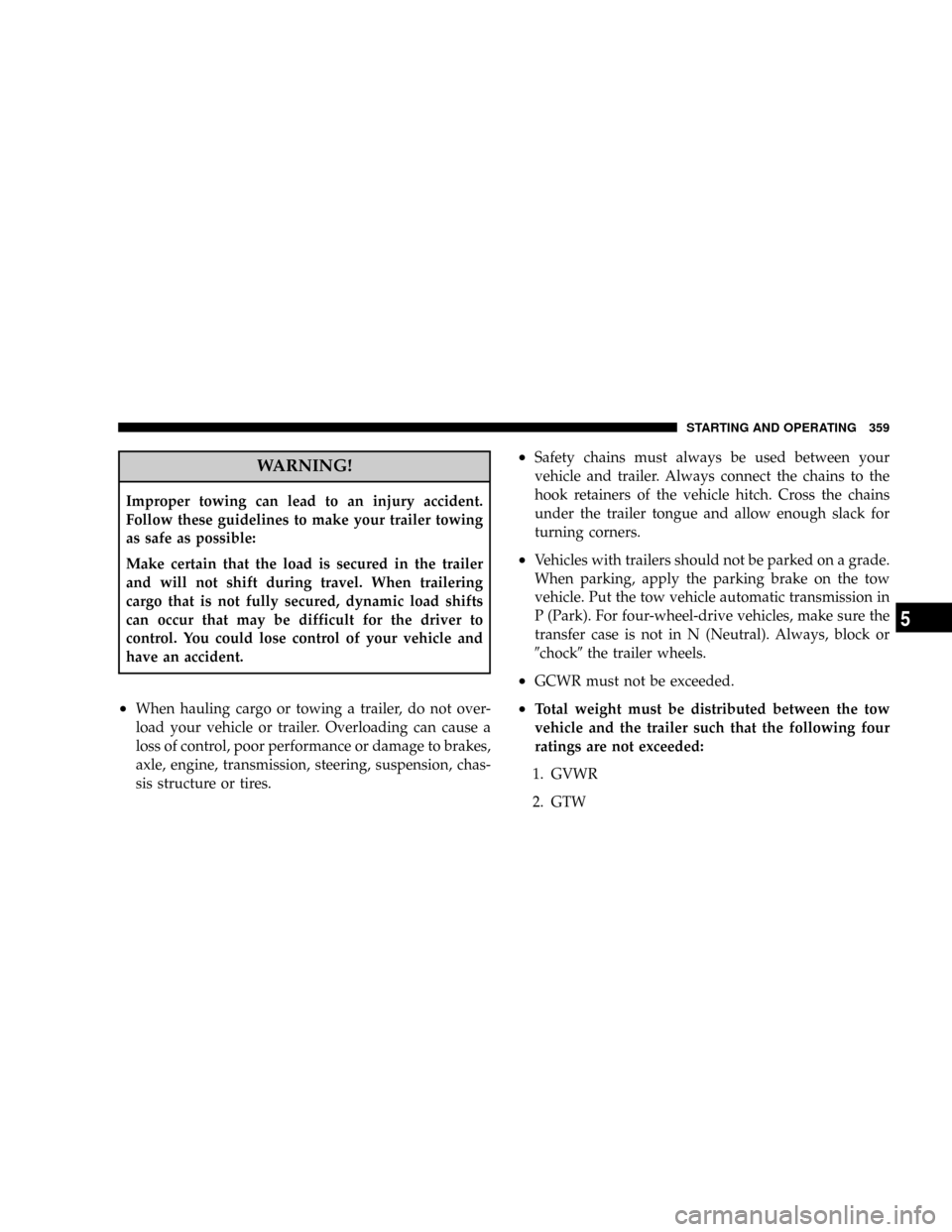JEEP GRAND CHEROKEE 2008 WK / 3.G Owners Manual
Manufacturer: JEEP, Model Year: 2008, Model line: GRAND CHEROKEE, Model: JEEP GRAND CHEROKEE 2008 WK / 3.GPages: 490, PDF Size: 6.86 MB
Page 351 of 490

TRAILER TOWING
In this section you will find safety tips and information
on limits to the type of towing you can reasonably do
with your vehicle. Before towing a trailer carefully re-
view this information to tow your load as efficiently and
safely as possible.
To maintain warranty coverage, follow the requirements
and recommendations in this manual concerning ve-
hicles used for trailer towing.
Common Towing Definitions
The following trailer towing related definitions will assist
you in understanding the following information:
Gross Vehicle Weight Rating (GVWR)
The GVWR is the total allowable weight of your vehicle.
This includes driver, passengers, cargo and tongue
weight. The total load must be limited so that you do not
exceed the GVWR.
Gross Trailer Weight (GTW)
The gross trailer weight (GTW) is the weight of the trailer
plus the weight of all cargo, consumables and equipment
(permanent or temporary) loaded in or on the trailer in its
9loaded and ready for operation9condition. The recom-
mended way to measure GTW is to put your fully loaded
trailer on a vehicle scale. The entire weight of the trailer
must be supported by the scale.
Gross Combination Weight Rating (GCWR)
The gross combination weight rating (GCWR) is the total
permissible weight of your vehicle and trailer when
weighed in combination. (Note that GCWR ratings in-
clude a 150 lbs (68 kg) allowance for the presence of a
driver).
STARTING AND OPERATING 351
5
Page 352 of 490

Gross Axle Weight Rating (GAWR)
The GAWR is the maximum capacity of the front and rear
axles. Distribute the load over the front and rear axles
evenly. Make sure that you do not exceed either front or
rear GAWR.
WARNING!
It is important that you do not exceed the maximum
front or rear GAWR. A dangerous driving condition
can result if either rating is exceeded. You could lose
control of the vehicle and have an accident.
Tongue Weight (TW)
The downward force exerted on the hitch ball by the
trailer. In most cases it should not be less than 10% or
more than 15% of the trailer load. You must consider this
as part of the load on your vehicle.
Frontal Area
The maximum height and maximum width of the front of
a trailer.
Weight-Carrying Hitch
A weight-carrying hitch supports the trailer tongue
weight, just as if it were luggage located at a hitch ball or
some other connecting point of the vehicle. These kind of
hitches are the most popular on the market today and
they're commonly used to tow small- and medium-sized
trailers.
Weight-Distributing Hitch
A weight-distributing system works by applying lever-
age through spring (load) bars. They are typically used
for heavier loads, to distribute trailer tongue weight to
the tow vehicle's front axle and the trailer axle(s). When
used in accordance with the manufacturers' directions, it
provides for a more level ride, offering more consistent
steering and brake control thereby enhancing towing
352 STARTING AND OPERATING
Page 353 of 490

safety. The addition of a friction/hydraulic sway control
also dampens sway caused by traffic and crosswinds and
contributes positively to tow vehicle and trailer stability.
Trailer sway control and a weight distributing (load
equalizing) hitch are recommended for heavier Tongue
Weights (TW) and may be required depending on Vehicle
and Trailer configuration/loading to comply with gross
axle weight rating (GAWR) requirements.
WARNING!
An improperly adjusted Weight Distributing Hitch
system may reduce handling, stability, braking per-
formance, and could result in an accident.
Weight Distributing Systems may not be compatible
with Surge Brake Couplers. Consult with your hitch
and trailer manufacturer or a reputable Recreational
Vehicle dealer for additional information.
Weight Distributing Hitch System
STARTING AND OPERATING 353
5
Page 354 of 490

Trailer Hitch Classification
Your vehicle may be factory equipped for safe towing of
trailers weighing over 3,500 lbs (1 587 kg) with the
optional Trailer Tow Prep Package. See your dealer for
package content.The following chart provides the industry standard for
the maximum trailer weight a given trailer hitch class can
tow and should be used to assist you in selecting the
correct trailer hitch for your intended towing condition.
Refer to the Trailer Towing Weights (Maximum Trailer
Weight Ratings) chart for the Max. GTW towable for your
given drivetrain.
Trailer Hitch Classification
Class Max. GTW (Gross Trailer
Wt.)
Class I - Light Duty 2,000 lbs (907 kg)
Class II - Medium
Duty3,500 lbs (1 587 kg)
Class III - Heavy Duty 5,000 lbs (2 268 kg)
Class IV - Extra
Heavy Duty10,000 lbs (4 540 kg)
All trailer hitches should be professionally installed on
your vehicle.
Improper Adjustment of Weight Distributing System
354 STARTING AND OPERATING
Page 355 of 490

Trailer Towing Weights (Maximum Trailer Weight Ratings)
The following chart provides the maximum trailer weight ratings towable for your given drivetrain.
Engine/Transmission Model GCWR (Gross Com-
bined Wt. Rating)Frontal Area Max. GTW (Gross
Trailer Wt.)Max. Tongue
Wt. (See Note
1)
3.7L/Automatic 4x2 8,000 lbs (3 629 kg) 35 Sq. Ft. (3.25
square meters)3,500 lbs (1 587 kg) 350 lbs (159 kg)
3.7L/Automatic 4x4 8,200 lbs (3 719 kg) 35 Sq. Ft. (3.25
square meters)3,500 lbs (1 587 kg) 350 lbs (159 kg)
4.7L/Automatic 4x2 8.560 lbs (3 883 kg) 35 Sq. Ft. (3.25
square meters)3,500 lbs (1 587 kg) 350 lbs (159 kg)
4.7L/Automatic 4x4 8,650 lbs (3 924 kg) 35 Sq. Ft. (3.25
square meters)3,500 lbs (1 587 kg) 350 lbs (159 kg)
4.7L/Automatic (w/
Trailer Tow Group IV)4x2 11,200 lbs (5 080 kg) 64 Sq. Ft. (5.95
square meters)6,500 lbs (2 948 kg) 650 lbs (295 kg)
4.7L/Automatic (w/
Trailer Tow Group IV)4x4 11,450 lbs (5 194 kg) 64 Sq. Ft. (5.95
square meters)6,500 lbs (2 948 kg) 650 lbs (295 kg)
5.7L/Automatic 4x2 12,200 lbs (5 534 kg) 64 Sq. Ft. (5.95
square meters)7,400 lbs (3 357 kg) 740 lbs (336 kg)
STARTING AND OPERATING 355
5
Page 356 of 490

5.7L/Automatic (Over-
land)4x2 12,200 lbs (5 534 kg) 64 Sq. Ft. (5.95
square meters)7,395 lbs (3 354 kg) 740 lbs (336 kg)
5.7L/Automatic 4x4 12,200 lbs (5 534 kg) 64 Sq. Ft. (5.95
square meters)7,200 lbs (3 266 kg) 720 lbs (327 kg)
3.0L Diesel/Automatic 4x2 12,200 lbs (5 534 kg) 64 Sq. Ft. (5.95
square meters)7,400 lbs (3 357 kg) 740 lbs (336 kg)
3.0L Diesel/Automatic 4x4 12,200 lbs (5 534 kg) 64 Sq. Ft. (5.95
square meters)7,200 lbs (3 266 kg) 720 lbs (327 kg)
Refer to local laws for maximum trailer towing speeds.
NOTE:The trailer tongue weight must be considered as
part of the combined weight of occupants and cargo, and
should never exceed the weight referenced on the Tire
and Loading Information placard. The addition of pas-
sengers and cargo may require reducing tongue load andGross Trailer Weight (GTW). Redistributing cargo (to the
trailer) may be necessary to avoid exceeding Rear Gross
Axle Weight Rating (GAWR) of 3,200 lbs (1 451 kg). Refer
to ªWeight Distributing Hitchº in this section. Refer to
the ªTire±Safety Informationº section in this manual.
356 STARTING AND OPERATING
Page 357 of 490

Trailer and Tongue Weight
Always load a trailer with 60% to 65% of the weight in
the front of the trailer. This places 10% to 15% of the
Gross Trailer Weight (GTW) on the tow hitch of your
vehicle. Loads balanced over the wheels or heavier in the
rear can cause the trailer to swayseverelyside to side
which will cause loss of control of vehicle and trailer.
Failure to load trailers heavier in front is the cause of
many trailer accidents.
Never exceed the maximum tongue weight stamped on
your trailer hitch.
Consider the following items when computing the
weight on the front/rear axles of the vehicle:
²The tongue weight of the trailer.
²The weight of any other type of cargo or equipment
put in or on your vehicle.
²The weight of the driver and all passengers.
STARTING AND OPERATING 357
5
Page 358 of 490

NOTE:Remember that everything put into or on the
trailer adds to the load on your vehicle. Also, additional
factory-installed options, or dealer-installed options,
must be considered as part of the total load on your
vehicle. Refer to the Tire and Loading Information plac-
ard in the ªTireÐSafety Informationº section of this
manual for the maximum combined weight of occupants
and cargo for your vehicle.
Towing Requirements
To promote proper break-in of your new vehicle driv-
etrain components the following guidelines are recom-
mended:
CAUTION!
²Avoid towing a trailer for the first 500 miles (805
km) of vehicle operation. Doing so may damage
your vehicle.
²During the first 500 miles (805 km) of trailer
towing, limit your speed to 50 mph (80 km/h).
Perform the maintenance listed in the ªMaintenance
Schedule.º Refer to Section 8 of this manual. When
towing a trailer, never exceed the GAWR, or GCWR,
ratings.
358 STARTING AND OPERATING
Page 359 of 490

WARNING!
Improper towing can lead to an injury accident.
Follow these guidelines to make your trailer towing
as safe as possible:
Make certain that the load is secured in the trailer
and will not shift during travel. When trailering
cargo that is not fully secured, dynamic load shifts
can occur that may be difficult for the driver to
control. You could lose control of your vehicle and
have an accident.
²When hauling cargo or towing a trailer, do not over-
load your vehicle or trailer. Overloading can cause a
loss of control, poor performance or damage to brakes,
axle, engine, transmission, steering, suspension, chas-
sis structure or tires.
²Safety chains must always be used between your
vehicle and trailer. Always connect the chains to the
hook retainers of the vehicle hitch. Cross the chains
under the trailer tongue and allow enough slack for
turning corners.
²Vehicles with trailers should not be parked on a grade.
When parking, apply the parking brake on the tow
vehicle. Put the tow vehicle automatic transmission in
P (Park). For four-wheel-drive vehicles, make sure the
transfer case is not in N (Neutral). Always, block or
9chock9the trailer wheels.
²GCWR must not be exceeded.
²Total weight must be distributed between the tow
vehicle and the trailer such that the following four
ratings are not exceeded:
1. GVWR
2. GTW
STARTING AND OPERATING 359
5
Page 360 of 490

3. GAWR
4. Tongue weight rating for the trailer hitch utilized
(This requirement may limit the ability to always
achieve the 10% to 15% range of tongue weight as a
percentage of total trailer weight).
Towing Requirements Ð Tires
þ
Do not attempt to tow a trailer while using a compact
spare tire.
þProper tire inflation pressures are essential to the safe
and satisfactory operation of your vehicle. Refer to the
ªTires±General Informationº section of this manual for
proper tire inflation procedures.
þAlso, check the trailer tires for proper tire inflation
pressures before trailer usage.
þCheck for signs of tire wear or visible tire damage
before towing a trailer. Refer to the ªTires±General
Informationº section of this manual for the proper
inspection procedure.
þWhen replacing tires, refer to the ªTires±General Infor-
mationº section of this manual for proper tire replace-
ment procedures. Replacing tires with a higher load
carrying capacity will not increase the vehicle's GVWR
and GAWR limits.
Towing Requirements Ð Trailer Brakes
þ
Donotinterconnect the hydraulic brake system or
vacuum system of your vehicle with that of the trailer.
This could cause inadequate braking and possible
personal injury.
360 STARTING AND OPERATING